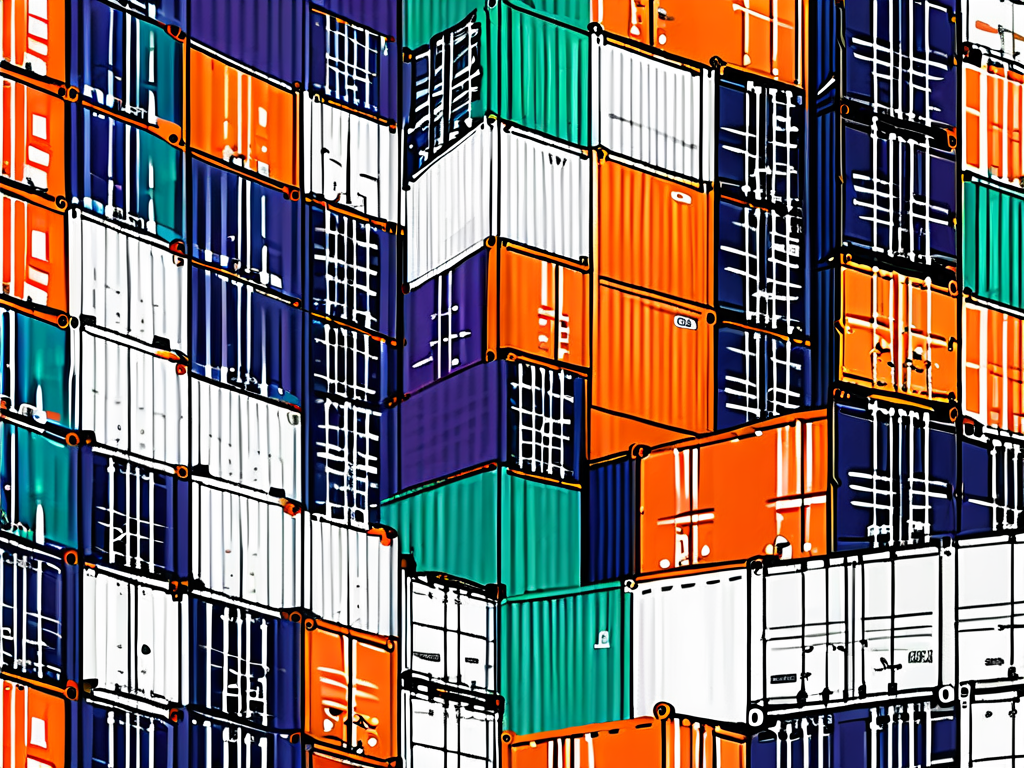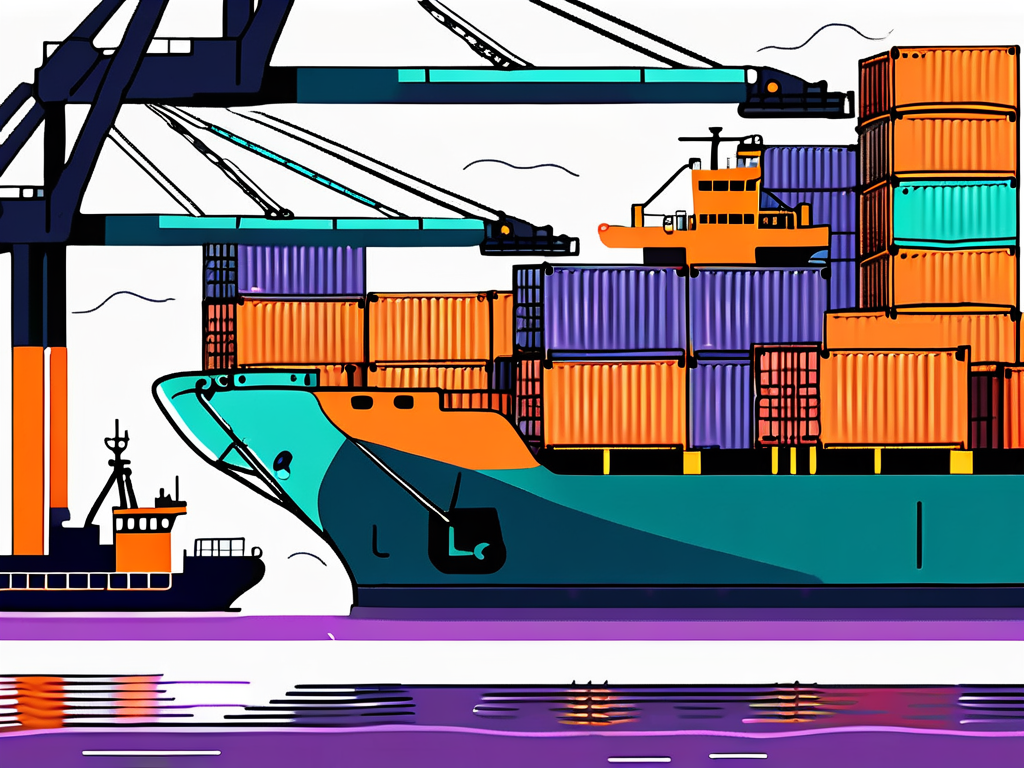Container ships are the workhorses of global trade, carrying an astonishing 90% of the world’s goods! These mighty vessels are marvels of engineering, capable of transporting massive amounts of cargo across oceans and seas.
But have you ever wondered how are container ships loaded? In this article, we’ll take a deep dive into:
- The loading process of container ships and the role of container ships in global trade
- The pre-loading process
- The loading procedure and the safety measures
- The post-loading procedure
Table of Contents
ToggleThe Loading Procedure of a Container Ship – Phase-by-Phase
A container ship is loaded by positioning containers according to a pre-planned stowage arrangement using cranes, stacking them in designated slots on the ship’s deck and hold, and securing them to ensure stability and safety during transit.
How to improve global supply chain management provides insights into how container ships facilitate global trade.These mammoth vessels are the backbone of international commerce, linking manufacturers, producers, and consumers from all corners of the globe.
They facilitate the movement of goods in a standardized and efficient manner, thanks to the ingenious use of shipping containers. 3PL services in the USA play a crucial role in managing containerized shipments, ensuring smooth logistics operations for businesses.
Container ships are not just massive carriers; they are engineering marvels designed to withstand the harsh conditions of the open sea.
These vessels can range in size from small feeder ships carrying a few hundred containers to ultra-large container ships capable of transporting over 20,000 containers on a single voyage.
The design and construction of these ships require careful consideration of factors such as stability, weight distribution, and propulsion systems to ensure safe and efficient transportation of cargo.
PHASE 1: The Pre-Loading Process
Before the containers can be loaded, a meticulous pre-loading process takes place to ensure everything is in order. This stage involves careful planning, organization, and preparation to guarantee a smooth and efficient loading operation.

Efficiency in the pre-loading process is crucial for the successful transportation of goods across the seas. Every detail is meticulously scrutinized to prevent any potential issues that may arise during the voyage.
From the smallest package to the largest container, each item plays a vital role in the intricate logistics puzzle that is maritime shipping.
Planning and Organizing the Load
The first step is meticulous planning and organizing of the cargo. This involves determining the optimal placement of containers, taking into account factors such as weight distribution, cargo type, and destination.
Best practices for shipping container logistics help ensure the stability and balance of containerized shipments.
Moreover, advanced technology and software are often employed to assist in the planning and organizing process. These tools provide real-time data on weather conditions, sea routes, and vessel capacity, allowing for precise calculations and adjustments to be made.
How to reduce logistics costs for businesses explores how companies use technology to streamline logistics.
Preparing the Containers for Shipping
Containers need to be shipshape before they can be loaded onto the vessel. This entails checking for any damages, ensuring proper labeling, and securing cargo within each container.
Containers undergo rigorous inspections to ensure they meet international shipping standards, ensuring the safety and integrity of their contents.
Additionally, specialized equipment and machinery are often utilized during the preparation phase to handle containers with care.
From crane operators lifting heavy loads to technicians conducting maintenance checks, a team of skilled professionals work together to ensure that each container is ready for its oceanic journey.
The attention to detail and dedication exhibited during the pre-loading process are paramount in upholding the standards of the shipping industry.
PHASE 2: The Loading Procedure
Once the pre-loading stage is complete, it’s time to put those massive cranes to work and begin loading the containers onto the ship. This highly orchestrated process requires precision, coordination, and above all, safety.

Before the cranes swing into action, a team of skilled operators meticulously inspects each crane to ensure it is in optimal working condition.
These cranes, often equipped with advanced technology such as anti-sway systems and remote control operation, stand as towering sentinels ready to hoist the containers with expert precision.
The Role of Cranes in Loading
Cranes are the unsung heroes of the loading operation. These towering giants gracefully lift the containers from the ground and carefully place them onto the ship’s deck. With their immense lifting capacity, cranes can handle multiple containers at once, speeding up the loading process significantly.
As the containers are lifted high into the air, the crane operators rely on hand signals and communication systems to ensure seamless coordination. Each container is positioned with utmost accuracy, fitting like a puzzle piece into the larger cargo plan of the ship.
Stacking and Securing Containers
Once on board, the containers are meticulously stacked using a specialized on-deck arrangement. This stacking method optimizes space and ensures maximum cargo capacity.
To safeguard against rough sea conditions, containers are secured in place using bracing, twist locks, and other specialized locking mechanisms.
Every twist lock and securing mechanism plays a crucial role in maintaining the stability of the cargo during the voyage. The crew works diligently to secure each container, knowing that proper stacking and securing are essential for the safety of the ship, its crew, and the valuable cargo it carries.
Safety Measures During Loading
Safety is of utmost importance during the loading process. Both the crew and the cargo must be protected from potential hazards that can arise from improper loading techniques.
Ensuring the safety of all personnel and goods on board a vessel during the loading process is a multifaceted task that requires meticulous planning and execution.
From the moment the cargo is brought to the port to its secure placement on the ship, every step is carefully monitored to prevent any mishaps that could jeopardize the safety of the crew and the integrity of the cargo.
Ensuring Balance and Stability
Container ships must maintain balance and stability to navigate through treacherous waters. To achieve this, the containers are strategically loaded, ensuring even weight distribution throughout the vessel. This uniform distribution prevents a shift in the ship’s center of gravity, mitigating the risk of capsizing.
How real-time tracking improves international shipments explains how technology enhances shipment stability and tracking.These systems provide real-time data to the crew, allowing them to make immediate adjustments if any imbalance is detected.
This proactive approach significantly enhances the safety of the vessel and its crew during the loading process and throughout the entire voyage.
Safety Protocols for Workers
Workers involved in the loading operation follow strict safety protocols to minimize accidents and injuries. They wear protective gear, receive extensive training, and adhere to safety guidelines throughout the loading process. Their expertise and vigilance ensure that the entire operation runs smoothly and without incident.
In addition to personal protective equipment, such as helmets, safety vests, and steel-toed boots, workers also undergo regular safety drills to prepare them for emergency situations.
These drills simulate various scenarios, such as fires or medical emergencies, allowing the workers to practice their response and evacuation procedures.
By being well-prepared and trained, the workers play a crucial role in maintaining a safe working environment during the high-stakes loading operations.
PHASE 3: Post-Loading Procedures
Once the containers are stowed on board, additional post-loading procedures are performed to ensure that everything is in order and the vessel is ready to set sail.
After the containers have been carefully loaded onto the ship, the crew meticulously goes through a series of double-checking procedures to guarantee the safety and security of the cargo.
This meticulous process involves inspecting each container to ensure it is properly sealed, labeled, and securely fastened. By conducting this final check, the crew can identify any potential issues such as loose containers or compromised cargo, thus mitigating any risks that could arise during the voyage.
Double Checking the Load
Before departure, the crew conducts a thorough inspection of the loaded containers. They verify that each container is correctly sealed, labeled, and securely fastened. This final check ensures that there are no loose containers or compromised cargo that could jeopardize the safety of the ship and its crew.
Furthermore, specialized equipment and technology are utilized during the double-checking process to ensure the accuracy and efficiency of the inspection.
This advanced technology aids the crew in swiftly identifying any discrepancies or irregularities in the containers, allowing for timely resolutions and preventing any potential issues from escalating.
Choosing the right shipping provider ensures safe and efficient cargo transport. Read our guide on choosing the right freight carrier for your business to make the best decision.
Preparing for Departure
With the load securely in place and all safety checks complete, the container ship is ready to embark on its journey across the vast oceans.
The crew finalizes preparations, ensuring that all systems are functioning correctly and that everything is in place for a smooth and successful voyage.
As we bid farewell to the container ship, laden with goods from all corners of the Earth, we gain a newfound appreciation for the extensive planning, coordination, and safety measures that go into loading these colossal vessels.
It’s a remarkable feat of human ingenuity and engineering, showcasing our ability to tame the seas and connect the world through global trade.
The Role of Container Ships in Global Trade
Container ships have revolutionized the way goods are transported worldwide. These floating giants enable businesses to seamlessly ship their products across continents, connecting markets and consumers like never before.
Without container ships, the global economy would grind to a halt, leaving supermarket shelves empty and online orders undelivered.
These vessels operate on established shipping routes, carrying a diverse range of cargo, from consumer goods and electronics to raw materials and machinery.
The efficiency of container ships lies in their ability to handle different types of cargo, thanks to the standardized container sizes that can be easily transferred between ships, trucks, and trains.
This intermodal transport system ensures a smooth flow of goods from manufacturing hubs to distribution centers and ultimately to end consumers.
For businesses navigating international logistics, global freight forwarding and shipping solutions ensure smooth transit and compliance with global trade regulations.
Key Components of a Container Ship
Now that we appreciate the critical role container ships play, let’s take a closer look at their key components. A typical container ship consists of several distinct sections, each essential for the loading and safe transport of cargo.
Bow:
- Front section.
- Houses navigation equipment and crew quarters.
Stern:
- Rear section.
- Contains propulsion systems, rudder, and additional crew facilities.
Main Deck:
- Location for the majority of container stowage.
- Containers are secured in place by twist locks.
Below Deck (Engine Room):
- Houses the ship’s engines.
- Contains auxiliary systems for electricity, climate control, and waste management.
Proper Loading of Shipping Containers Prevent Potential Losses
The departure of a container ship symbolizes not just a voyage across waters but also the interconnectedness of the global economy. Each container holds within it a story of production, trade, and consumption, representing the intricate web of relationships that bind nations and cultures together.
The journey of these containers is a testament to the human endeavor to bridge distances and foster collaboration on a worldwide scale.
Looking for a reliable fulfillment partner? Get in touch with us today to streamline your logistics and enhance efficiency.






